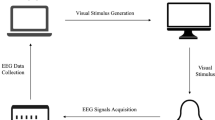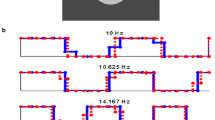Abstract
Purpose
Steady-state visual evoked potentials have various applications, including objective acuity testing. However, a non-monotonous spatial-frequency tuning (a “notch”) occurs at intermediate spatial frequencies in about half of the examinees. One possible reason lies in the temporal superposition of single-stimulus responses. This was investigated in 20 subjects.
Methods
Single-stimulus responses to checkerboard onsets were estimated through deconvolution of responses to m-sequence stimulation. Based on these, steady-state responses were predicted through superposition of temporally overlapping single-stimulus responses and compared to normally recorded steady-state responses. Discrepancies were analyzed in both the time and frequency domains.
Results
The agreement between predicted and recorded steady-state responses varied greatly among subjects, ranging from a good match including non-monotonous features of the tuning curve to substantial deviations. Although in some subjects the tuning of the recorded responses was better matched by the predicted responses than by the deconvolved m-sequence responses from which the prediction was computed, the correlation was not significantly different at the group level. In most subjects, there was only a small to moderate contribution of higher harmonics. The match between predicted and recorded responses was not always uniform across electrode locations.
Conclusions
Our data are consistent with temporal superposition explaining an interindividually variable part of the checksize tuning curve without being its primary determinant.







Similar content being viewed by others
References
Bach M, Meigen T (1999) Do’s and don’ts in Fourier analysis of steady-state potentials. Doc Ophthalmol 99:69–82. doi:10.1023/A:1002648202420
Bach M, Maurer JP, Wolf ME (2008) VEP-based acuity assessment in normal vision, artificially degraded vision, and in patients. Br J Ophthalmol 92:396–403. doi:10.1136/bjo.2007.130245
Bohórquez J, Ozdamar O (2008) Generation of the 40-Hz auditory steady-state response (ASSR) explained using convolution. Clin Neurophysiol 119(11):2598–2607. doi:10.1016/j.clinph.2008.08.002
Capilla A, Pazo-Alvarez P, Darriba A, Campo P, Gross J (2011) Steady-state visual evoked potentials can be explained by temporal superposition of transient event-related responses. PLoS One 6(1):e14,543. doi:10.1371/journal.pone.0014543
Dawson R (2011) How significant is a boxplot outlier. J Stat Educ 19(2). www.amstat.org/publications/jse/v19n2/dawson
Dobie RA, Wilson MJ (1993) Objective response detection in the frequency domain. Electroencephalogr Clin Neurophysiol 88(6):516–524. doi:10.1016/0168-5597(93)90040-V
Gutowitz H, Zemon V, Victor J, Knight BW (1986) Source geometry and dynamics of the visual evoked potential. Electroencephalogr Clin Neurophysiol 64(4):308–327. doi:10.1016/0013-4694(86)90155-0
Harter MR, White CT (1968) Effects of contour sharpness and check-size on visually evoked cortical potentials. Vis Res 8(6):701–711. doi:10.1016/0042-6989(68)90044-8
Heinrich SP (2007) A primer on motion visual evoked potentials. Doc Ophthalmol 114:83–105. doi:10.1007/s10633-006-9043-8
Heinrich SP (2009) Permutation-based significance tests for multi-harmonic steady-state evoked potentials. IEEE Trans Biomed Eng 56:534–537. doi:10.1109/TBME.2008.2006021
Heinrich SP (2010) Some thoughts on the interpretation of steady-state evoked potentials. Doc Ophthalmol 120(3):205–214. doi:10.1007/s10633-010-9212-7
Heinrich SP, Bach M (2003) Adaptation characteristics of steady-state motion visual evoked potentials. Clin Neurophysiol 114:1359–1366. doi:10.1016/S1388-2457(03)00088-9
Höffken O, Grehl T, Dinse HR, Tegenthoff M, Bach M (2008) Paired-pulse behavior of visually evoked potentials recorded in human visual cortex using patterned paired-pulse stimulation. Exp Brain Res 188(3):427–435. doi:10.1007/s00221-008-1374-0
Joost W, Bach M (1990) Variability of the steady-state visually evoked potential: interindividual variance and intraindividual reproducibility of spatial frequency tuning. Doc Ophthalmol 75(1):59–66. doi:10.1007/BF0014259
Liavas AP, Moustakides GV, Henning G, Psarakis EZ, Husar P (1998) A periodogram-based method for the detection of steady-state visually evoked potentials. IEEE Trans Biomed Eng 45:242–248. doi:10.1109/10.661272
Meigen T, Bach M (1999) On the statistical significance of electrophysiological steady-state responses. Doc Ophthalmol 98:207–232. doi:10.1023/A:1002097208337
Norcia AM, Sato T, Shinn P, Mertus J (1986) Methods for the identification of evoked response components in the frequency and combined time/frequency domains. Electroencephalogr Clin Neurophysiol 65(3):212–226. doi:10.1016/0168-5597(86)90056-0
Peyk P, Schupp HT, Keil A, Elbert T, Junghöfer M (2009) Parallel processing of affective visual stimuli. Psychophysiology 46(1):200–208. doi:10.1111/j.1469-8986.2008.00755.x
Skrandies W (2007) The effect of stimulation frequency and retinal stimulus location on visual evoked potential topography. Brain Topogr 20(1):15–20. doi:10.1007/s10548-007-0026-1
Spekreijse H, van der Tweel LH, Zuidema T (1973) Contrast evoked responses in man. Vis Res 13:1577–1601. doi:10.1016/0042-6989(73)90016-3
Strasburger H, Scheidler W, Rentschler I (1988) Amplitude and phase characteristics of the steady-state visual evoked potential. Appl Optics 27:1069–1088. doi:10.1364/AO.27.001069
Strasburger H, Murray IJ, Remky A (1993) Sustained and transient mechanisms in the steady-state visual evoked potential: onset presentation compared to pattern reversal. Clin Vis Sci 8:211–234
Sutter EE (1987) A practical nonstochastic approach to nonlinear time-domain analysis. In: Marmarelis VZ (ed) Advanced methods of physiological systems modeling, vol 1. Biomedical Simulations Resource, Los Angeles, pp 303–315
Tyler CW, Apkarian P, Nakayama K (1978) Multiple spatial-frequency tuning of electrical responses from human visual cortex. Exp Brain Res 33(3–4):535–550. doi:10.1007/BF00235573
Victor JD, Mast J (1990) A new statistic for steady-state evoked potentials. Electroenceph Clin Neurophysiol 78:378–388. doi:10.1016/0013-4694(91)90099-p
Acknowledgments
We gratefully acknowledge support by the Deutsche Forschungsgemeinschaft (BA 877/21) and thank our subjects for their participation.
Author information
Authors and Affiliations
Corresponding author
Rights and permissions
About this article
Cite this article
Heinrich, S.P., Groten, M. & Bach, M. Relating the steady-state visual evoked potential to single-stimulus responses derived from m-sequence stimulation. Doc Ophthalmol 131, 13–24 (2015). https://doi.org/10.1007/s10633-015-9492-z
Received:
Accepted:
Published:
Issue Date:
DOI: https://doi.org/10.1007/s10633-015-9492-z




